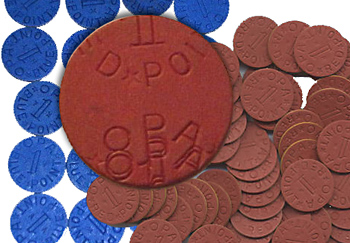|
"Making Cents"
Saturday, August 9, 2008
| D |
Each household was issued ration books based on a variety of factors: number of people in the household, ages, children under the age of 3, elderly, and handicapped. These ration booklets contained various small stamps which had no cash value, but were required to purchase food items — for example four "B" stamps for each pound of ground beef or five "A" stamps for a bag of sugar. All store items had a price marked as well as a ration book stamp requirement. So every purchase had to also include the right number of ration stamps.
Other items came under the OPA including tires and gasoline. Cars had to display a gasoline assignment sticker — A, B, or C, indicating the quantity of gas one could purchase at one time. Drivers were issued ration stamps to meet their needs; truckers and cab drivers got more than passenger cars. Some vehicles were forced to be out of service for the war due to a lack of stamps for tires and or gasoline.
The price of the item was not a factor in the use of these stamps. However, to make exact change, shopkeepers were issued small red and or blue tokens. They were made of a vulcanized fiber and were 16-mm in diameter. These basically were "small change" for stamps from ration books.
The blue tokens had a value of one point and had two letters and read "OPA Blue Point 1." There are 24 different letter combinations known for the blue tokens. The red tokens similarly read "OPA Red Point 1" and came in 30 different letter combinations. Some products required red tokens in change while other products required blue tokens as change.
These tokens were issued from 1942 to 1945 when rationing ended. The letters seem to have had no specific meaning and were apparently random.
On various price lists, the blue tokens sell for 80 cents and the red tokens for 40 cents. The few scarcer letters sell for $2 and $4. Error pieces — usually off-center or double-struck pieces — are more valuable, with prices shown online of $2.50 to $6 for off-center pieces and $5 to $6.50 for double-struck pieces. On eBay, groups of such tokens often sell for less than 10 cents each.
Many households of this era still have some of these tokens as well as partially used ration books. The number of tokens issued was in the billions, and even though most have been destroyed or lost, quite a few remain for collectors today.
©2008 SCV COMMUNICATIONS GROUP & SOL TAYLOR · ALL RIGHTS RESERVED.

![[Most Recent Quotes from www.kitco.com]](http://www.kitconet.com/images/quotes_special.gif)

